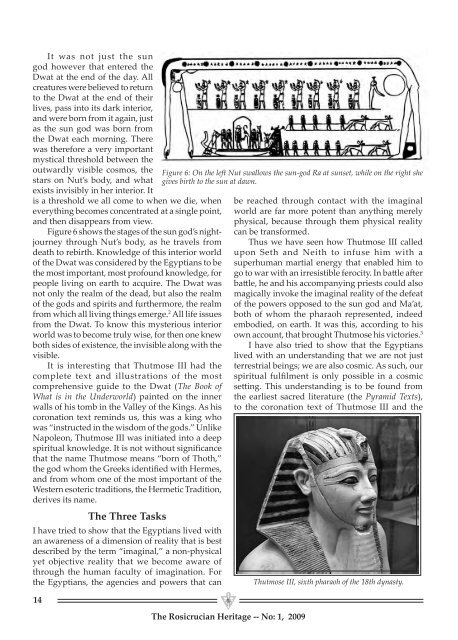Rosicrucian Heritage Magazine - 2009-03 - AMORC
Rosicrucian Heritage Magazine - 2009-03 - AMORC
Rosicrucian Heritage Magazine - 2009-03 - AMORC
You also want an ePaper? Increase the reach of your titles
YUMPU automatically turns print PDFs into web optimized ePapers that Google loves.
It was not just the sun<br />
god however that entered the<br />
Dwat at the end of the day. All<br />
creatures were believed to return<br />
to the Dwat at the end of their<br />
lives, pass into its dark interior,<br />
and were born from it again, just<br />
as the sun god was born from<br />
the Dwat each morning. There<br />
was therefore a very important<br />
mystical threshold between the<br />
outwardly visible cosmos, the<br />
stars on Nut’s body, and what<br />
exists invisibly in her interior. It<br />
is a threshold we all come to when we die, when<br />
everything becomes concentrated at a single point,<br />
and then disappears from view.<br />
Figure 6 shows the stages of the sun god’s nightjourney<br />
through Nut’s body, as he travels from<br />
death to rebirth. Knowledge of this interior world<br />
of the Dwat was considered by the Egyptians to be<br />
the most important, most profound knowledge, for<br />
people living on earth to acquire. The Dwat was<br />
not only the realm of the dead, but also the realm<br />
of the gods and spirits and furthermore, the realm<br />
from which all living things emerge. 2 All life issues<br />
from the Dwat. To know this mysterious interior<br />
world was to become truly wise, for then one knew<br />
both sides of existence, the invisible along with the<br />
visible.<br />
It is interesting that Thutmose III had the<br />
complete text and illustrations of the most<br />
comprehensive guide to the Dwat (The Book of<br />
What is in the Underworld) painted on the inner<br />
walls of his tomb in the Valley of the Kings. As his<br />
coronation text reminds us, this was a king who<br />
was “instructed in the wisdom of the gods.” Unlike<br />
Napoleon, Thutmose III was initiated into a deep<br />
spiritual knowledge. It is not without significance<br />
that the name Thutmose means “born of Thoth,”<br />
the god whom the Greeks identified with Hermes,<br />
and from whom one of the most important of the<br />
Western esoteric traditions, the Hermetic Tradition,<br />
derives its name.<br />
The Three Tasks<br />
I have tried to show that the Egyptians lived with<br />
an awareness of a dimension of reality that is best<br />
described by the term “imaginal,” a non-physical<br />
yet objective reality that we become aware of<br />
through the human faculty of imagination. For<br />
the Egyptians, the agencies and powers that can<br />
14<br />
Figure 6: On the left Nut swallows the sun-god Ra at sunset, while on the right she<br />
gives birth to the sun at dawn.<br />
The <strong>Rosicrucian</strong> <strong>Heritage</strong> -- No: 1, <strong>2009</strong><br />
be reached through contact with the imaginal<br />
world are far more potent than anything merely<br />
physical, because through them physical reality<br />
can be transformed.<br />
Thus we have seen how Thutmose III called<br />
upon Seth and Neith to infuse him with a<br />
superhuman martial energy that enabled him to<br />
go to war with an irresistible ferocity. In battle after<br />
battle, he and his accompanying priests could also<br />
magically invoke the imaginal reality of the defeat<br />
of the powers opposed to the sun god and Ma’at,<br />
both of whom the pharaoh represented, indeed<br />
embodied, on earth. It was this, according to his<br />
own account, that brought Thutmose his victories. 3<br />
I have also tried to show that the Egyptians<br />
lived with an understanding that we are not just<br />
terrestrial beings; we are also cosmic. As such, our<br />
spiritual fulfilment is only possible in a cosmic<br />
setting. This understanding is to be found from<br />
the earliest sacred literature (the Pyramid Texts),<br />
to the coronation text of Thutmose III and the<br />
Thutmose III, sixth pharaoh of the 18th dynasty.












